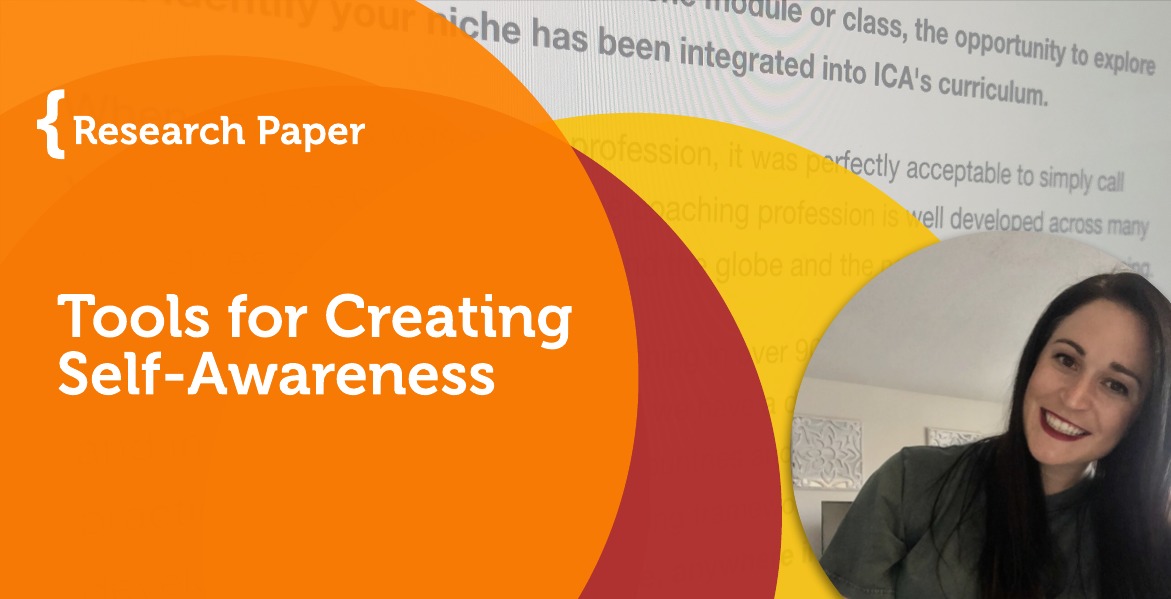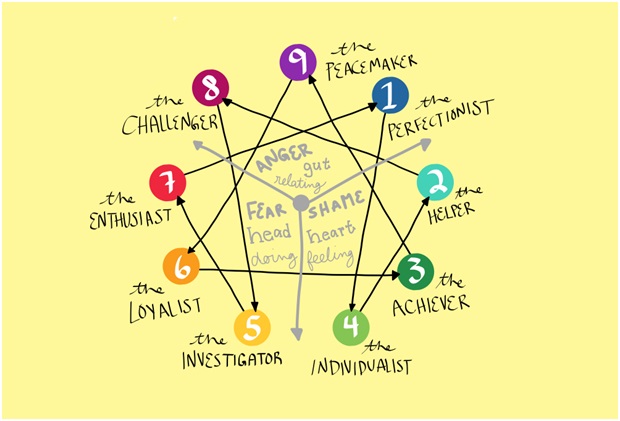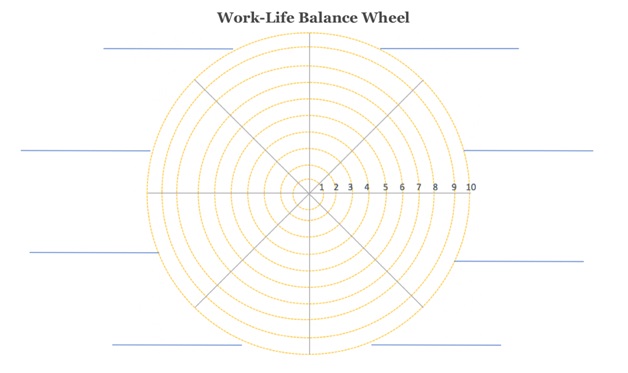
Research Paper By Nicole Kett
(Transformational Coach, UNITED STATES)
Building Self-Awareness as a Foundation For Change
In our fast-paced world, specifically in the United States, we move so quickly we barely have time to reflect on our experiences in the day today. We are constantly bombarded by distractions and technology that helps up get things done quickly and easily, but this increases the pressure for things to happen instantaneously. Under stress, our reptilian response systems are activated in the brain, shutting down the higher levels of brain function, and making it nearly impossible to connect with our deepest thoughts and values. We lose our ability to be creative, nurturing, and empathetic (Szalavitz and Perry, 2010).
Goleman (1998) says the pace of modern life gives us little time to reflect yet our bodies are wired to a much slower rhythm. Our emotions need space and time to be processed, and without this time, they are pushed underground. Our inner voice often offers a navigating rudder to help us move through life, but without intentionally creating space to listen to this voice, we can become misdirected.
Silbee (2008) says: “to know ourselves is to understand our nature as biological organisms who received certain stories we came to hold as true, as people who have unique genetic endowments and histories, and as the inevitable cumulative products of both our deep histories and every choice we have ever made (p. 38).” To understand who we are we must understand the experiences that have shaped us, our values, and our behaviors.
Gaining an understanding of ourselves makes it more likely that we will be more empowered to act in the alignment of who we are when we are faced with challenges (Sully, 1997). We also gain a better understanding of our strengths in situations and risks we may face. Greater self-awareness allows us to create a life that aligns with our motivations and is an important step before exploring a client’s goals. The good news is that self-awareness can be created, and by developing a greater sense of self we can increase our chances of acting in alignment with our authentic selves. In this paper, I will explore the practical applications for coaches and clients to begin to create self-awareness in the early phases of coaching to create a strong foundation for change.
The Self-Awareness Process
-
Assessment Tools – Enneagram
Assessment tools can be used to begin to get a better understanding of who we are and how we act. They allow for an unbiased perspective on our strengths and our weaknesses and allow us to take steps to grow professionally and personally. Tests such as MBTI, DISC, and Clifton Strengths Finder are some of the most popular in understanding our personality. A test that is very effective in understanding motivations for behavior is the enneagram. The enneagram is a map of nine different personality styles and patterns for behavior that were developed in childhood (Hoffman, 2018). The enneagram doesn’t put people in a box, but instead shows motivations for behavior styles and provides a roadmap out of constraints. It allows for a lot of personal development and growth. The enneagram has nine numbers which represent different characteristics. Within each number, there are healthy, average, and unhealthy characteristics. This test gives information into an individual’s motivations for their behaviors and it stays relatively stable throughout life. Personality can be acted out based on environment and other conditions, but if we understand motivations then we gain greater awareness as to who we are at our core. Each number or enneagram type also belongs to a “center” and as depicted below,
 Image from: https://i1.wp.com/sffoghorn.com/wp-content/uploads/2019/11/ennegram-map.jpg?w=998
Image from: https://i1.wp.com/sffoghorn.com/wp-content/uploads/2019/11/ennegram-map.jpg?w=998
these are gut, head, and heart. Each center has a dominant emotion which is anger, shame, and fear. Additionally, the enneagram provides a deeper understanding of each individual by bringing in the understanding of a “wing”. The wings are the numbers adjacent to the dominant type number, and individuals can take on traits of either wing or both.
Assessment tools—specifically the enneagram—can help to uncover who we are and patterns that are associated with who we are. This may also help bring unconscious beliefs into consciousness so we have the choice to act in ways that promote our growth.
-
Values
An understanding of our values can help us live our life the way that we want to. Values are “what a person finds to be important and wants to be doing with his or her life” (Selva, 2019). They are important because they define who we are and how we see the world. When we honor our values consistently, we experience life fulfillment. Creating self-awareness around our values allows us to make sure we are living in alignment with who we are, not living out values that have been imposed on us by external forces. Without having well-defined values, we can make decisions that are out of alignment with who we are, leading to great stress and anxiety, as well as feelings of helplessness (Selva, 2019).
To understand our values, we have to take the time to reflect on them. Values can be changed and impacted by our life experiences. They also can be drawn tied to our motivations for behavior which can be illustrated by the enneagram. For example, it is a great exercise to derive which values may come from our personality styles.
 Image from: https://withanopenheartdotorg.files.wordpress.com/2013/07/values-mind-map.png?w=1432&h=946
Image from: https://withanopenheartdotorg.files.wordpress.com/2013/07/values-mind-map.png?w=1432&h=946
Many simple exercises can be done for both the coach and the client to narrow down our top 5-10 values which give us the awareness to make intentional choices to live our lives in alignment with what we value.
Priming exercise reflection:
First, a general reflection is important in priming us to recognize what we value.
Next, you want to start with a wide range of values:

Rank each value 1-5. Circle all values you ranked as 5. Group any values that are similar together into categories. Next, narrow down your values to your top 25. Finally, choose your top 5-10.
As you narrow down to your top 5-10—here are some further reflection questions:
-
Wheel of Life
The wheel of life is a tool that can be used to evaluate our lives based on our values in our lives. It can give us a bird’s eye view of our life and how satisfied we are in living out our current values. Using a blank wheel, the client can identify 8 areas of their lives that are important to them. This can be a value, or a role that you play (eg. Mother, father, coach, partner), or an area of your life. For each category, the client will rate each area 1-10 with 10 being complete satisfaction. Examples of categories include health, relationships, social, financial, professional, personal growth, spirituality, and travel.

The gaps of the wheel are we can begin to spend some time. Thinking about each level, the client will reflect on where they believe their ideal would be. A balanced life does not mean reaching a 10 in each area but instead is about taking action to reach “ideal” levels in each area. The client can plot their ideal scores around the wheel as well. Once there is a greater awareness of which areas need tending to, the client can then start SMART Goals –Specific, Measurable, Achievable, Relevant, Time-Bound.
Questions for reflection:
Once there is a greater awareness of which areas need tending to, the client can then start SMART Goals –Specific, Measurable, Achievable, Relevant, Time-Bound. In this way, the wheel of life is a great tool to use in preparation for goal setting. It can also be a helpful tool to use as your life shifts over time and your priorities change. The wheel of life helps us to examine our blind spots and make improvements towards living the life we desire.
-
Mindfulness
Mindfulness can also be a useful tool for self-awareness. To be self-aware, individuals have to set aside time for self-observation. Mindfulness is a state where you can observe your thoughts and emotions without judging them. Mindfulness allows us to change the relationship that we have with our thoughts—we let them pass through our awareness without being drawn into them. It is in this space for our thoughts that we allow ourselves the choice of how to act.
Here’s an activity adapted from Doug Silsbee’s Presence-Based Coaching that can be used for mindfulness:
Sit up straight in a chair that supports your back. Keeping your back straight, allow your feet to rest comfortably on the floor. Keep your head erect and over your shoulders, but don’t strain. You may close your eyes or let your gaze rest softly on a blank wall several feet in front of you. Bring your awareness to your breath. Depending on what’s more noticeable for you, you might choose to attend to your abdomen rising and falling as you breathe. Or you might focus your attention in your nostrils, where the air moving in produces a certain coolness. Either location is fine. Simply bring your attention to the place you select. Don’t try to do anything in particular with your breathing. Begin to observe the sensation as the air moves in and out. To yourself, speak the words “breathing in” during your inhale and “breathing out” during your exhale. If you find your attention wandering (and you will—that’s part of the game!), observe that your attention is elsewhere and bring your attention back to your breath. If you notice any self-criticism about not being good at this, notice that and bring your attention back to the breath.
This exercise can be done ten minutes a day. Twenty is best, but five is better than one. If possible, do it once in the morning and once in the evening. It is important to be consistent, to sit, relax the body, slow the pulse, let go of stress, and train attention. Over time, this will allow you to be present with other people, as well as on tasks. Mindfulness can help an individual start to understand their emotions and experiences without feeling overwhelmed. It will help them become more self-aware of their emotions and mood orientations (Silsbee, 2008).
-
Journaling
Writing in a journal each day is a great way to see patterns in your life. It is an opportunity to reflect on your experiences, strengths, passions, and challenges. The better our ability to self-reflect, the more we can self-regulate and navigate our social environments (Morin, 2011). In the process of recollection, past personal events activate our medial prefrontal cortex and peripheral brain structures which make us more self-aware. Journaling is an effective way to improve one’s self-awareness and to promote reflection of the self. This can improve the individual’s ability to make changes in their thoughts, moods, and perceptions (Fritson and Mandernach, 2009). Guided journaling that focuses on the writer’s experiences can help create learning and significance for the writer. This process has been shown to increase the writer’s self-awareness (Fink, 2003).
Below are some journal prompts to begin the self-exploration process:
- What are parts of your upbringing that shaped you? Give three positives and three negatives that came as a result.
- Describe three particular challenges in your life that shaped who you are. How did you overcome the challenge and what did you learn?
- What is your biggest fear in life and why?
- What are three of your most proud moments? Why?
- Describe your relationship with your immediate family members. What are the positives of each and what is the hardest part of each of these relationships?
- What is a lesson you have learned in the past year?
- If you could tell your younger self one thing what would it be and why?
- Reflect on your hardest memory as a child, teenager, young adult, and adult. What made it so challenging?
- How would you describe yourself?
- What is your biggest weakness?
- Think about a time when you felt like you were on a roll in life. What do you see? What were you doing, feeling, and thinking? Why was this so exciting?
Boud et al. (1985) suggest that for a student to learn from reflection, they have to be able to reflect at a level that they are challenged in their previously held beliefs and knowledge. This level of reflection is what prompts the growth of new skills and behaviors. While each of these above exercises is a great way to increase self-awareness, working with a coach helps to support these structures. A coach can create even greater awareness of a client and help them see underlying thought patterns and beliefs that get in the way of their goals. The coach can use powerful questions to help the client see things from a different perspective. Even more simply, just mirroring back to the client can create awareness. The above exercises set a strong foundation of self-awareness for the client in the beginning phases of coaching and will support future goals and change.
References
“17 Self-Awareness Activities and Exercises (+ Test).” PositivePsychology.com, 18 Mar. 2020, positivepsychology.com/self-awareness-exercises-activities-test/.
Boud, David, et al. Reflection Turning Experience into Learning. Taylor & Francis Ltd, 2015.
Fink, L. Dee. Creating Significant Learning Experiences: an Integrated Approach to Designing College Courses. Jossey-Bass, 2003.
Friston, Krista K., and B. Jean Mandernach. “Impact of Journaling on Students’ Self-Efficacy & Locus of Control.” PsycEXTRA Dataset, 2009, DOI:10.1037/e741342011-010.
Goleman, Daniel. Emotional Intelligence. Bantam Books, 2006.
Goleman, Daniel. Working with Emotional Intelligence. Bantam Books, 1998.
Hoffman, Theresa. “Jumpstart Self-Awareness Using the Enneagram.” Thrive Leadership, Thrive Leadership, 18 July 2018, thriveleadership.com/blog/2018/7/18/jumpstart-self-awareness-using-the-enneagram.
Morin, Alain. “Self-Awareness Part 1: Definition, Measures, Effects, Functions, and Antecedents.” Social and Personality Psychology Compass, vol. 5, no. 10, 2011, pp. 807–823., DOI:10.1111/j.1751-9004.2011.00387.x.
Perry, Bruce Duncan. Born for Love: Why Empathy Is Essential – and Endangered. HarperPaperbacks, 2011.
Selva, Joaquin. “Values Clarification: How Reflection On Core Values Is Used In CBT.” PositivePsychology.com, 20 Nov. 2019, positivepsychology.com/values-clarification/.
Silsbee, Douglas K. Presence-Based Coaching: Cultivating Self-Generative Leaders through Mind, Body, and Heart. Jossey-Bass, 2008.
Sully, Sarah E. “Jstor.” D-Lib Magazine, vol. 3, no. 1, 1997, DOI:10.1045/january97-sully.